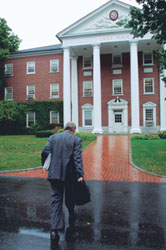Moving Pictures
The nonstop Don Harward gives a grudging glimpse of a presidency in motion
Story and photos by Phillis Graber Jensen

Don Harward has little patience for a camera pointed in his direction. “Do we own stock in Kodak?” he asked a few years ago after I pressed the shutter one too many times while photographing him (not by his request, of course) with a visitor in his Lane Hall office. At the time, I interpreted the comment as a barometer of his fiscal prudence. Yet in the two months I’ve shot documentary photos of his work, I’ve discovered frugality doesn’t adequately cover his distaste for photos where he’s the centerpiece.
Besides an academic’s disdain for what he might consider the predictable, the trite, and the hackneyed (he’ll grant that not all reportage qualifies as such), the sixth president of Bates College wants to protect the anonymity – and thereby the integrity, in his view – of his myriad commitments to both the institution and its people. Keenly aware of the authority his position gives him, he quite naturally fears upsetting the dynamic between him and a student or a colleague, who might think he’s using this photographer to buttress his “legacy.”
As a president who has worked tirelessly to gain the trust of students, faculty, staff, and administrators, Harward is not inclined to jeopardize that confidence by opening up his world to a little black box, some nosy lenses, or an insistent strobe light that bounces crazily off the ceiling. Every click reminds the president that it’s not just he and Ludwig Wittgenstein in the room. (A portrait of the Viennese philosopher hangs in the president’s office.)
Harward’s desk alone contains about eight feet of files. (It might be fun to measure how far the sheets of paper within would stretch if placed side by side.) The documents within the file folders (printed in the president’s favored 10-point, Times New Roman font) reflect the president’s mastery of thousands of topics, from the confidential applications of seniors for prestigious post-graduate fellowships to the reports on needed repairs to the Chapel masonry.
The documents don’t, however, reveal the periodic but pure pleasure that marks exchanges with those he encounters. A parent sends an e-mail filled with gratitude for a comforting talk the president delivered during a post-Sept. 11 dinner. Two students – part of a coalition pushing Bates to purchase non-sweatshop clothing – register delight during a conference call with Harward, chaplain Kerry Maloney, College Store director Sarah Potter ’77, and Trustee Joe Matzkin ’66, as the team creates an ethical purchasing policy. Prior to the annual Bates holiday meal for faculty and staff in December, Ann and Don Harward tie on aprons to serve dining service employees their meal.
“Day-in-the-life” stories have been around since Erich Salomon, the father of candid photography, took unposed pictures of German diplomats in 1928. Today’s leading news magazines offer a regular diet of photojournalism of behind-the-scenes Washington. These images are historical documents and also offer the public an opportunity to see their leaders as human beings – through an isolated gesture or an expression – rather than bureaucratic figureheads. For Bates, photographs of the president can be a simple but meaningful part of the College’s history. At least, that’s what I told Don seeking permission to take them. Perhaps seeing how the project might serve a Bates purpose, he finally agreed.